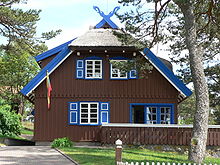Asvieniai
- Asvieniai
-

Ašvieniai, communément nommés les
petits chevaux, au sommet du toit d'une maison de
Nida
Les Ašvieniai sont, dans la mythologie lituanienne des jumeaux divins similaires aux Dieva deli de la mythologie lettonne, directement issus de la mythologie védique. Les deux noms sont issus de la même racine, c'est-à-dire d'un mot proto-indo-européen signifiant cheval : ek'w-[1].
Les Ašvieniai sont les fiancés de Saulė, la déesse du soleil. L'un d'eux est un cheval noir. Les Ašvieniai semblent avoir quelques similitudes avec Ūsinis (dans la mythologie lettonne, USINS), le dieu des chevaux.
Les Ašvieniai sont habituellement représentés comme des chevaux (en vieux lituanien, ašvienis signifie "un cheval"), parfois de couleur rouge coq, symbole de l'incendie. Les symboles et les chiffres des Ašvieniai sont utilisés dans l'architecture populaire, en particulier sur le haut des toits. Placés sur le toit, les symboles des Ašvieniai protègent des mauvais esprits. Parfois, les Ašvieniai sont représentés tirant le chariot de Saulė à travers le ciel. Ils sont aussi connus sous les noms de Saules žirgeliai ( "Petits chevaux du soleil") et Dievo sūneliai ( "Petits Fils de Dieu").
Notes et références
Voir aussi
Articles connexes
Wikimedia Foundation.
2010.
Contenu soumis à la licence CC-BY-SA. Source : Article Asvieniai de Wikipédia en français (auteurs)
Regardez d'autres dictionnaires:
Ašvieniai — in Lithuanian mythology are divine twins identical to Latvian Dieva deli and direct counterparts of Vedic Asvins. The both names derive from the same Proto Indo European root for the horse * ek w . [ [http://starling.rinet.ru/cgi… … Wikipedia
Divine twins — Ašvieniai, commonly called as the little horses, on the rooftop of a house in Nida The Divine twins are a mytheme of Proto Indo European mythology. the Greek Dioscuri the Vedic Ashvins the Lithuanian Ašvieniai the Latvian Dieva dēli Alcis (gods) … Wikipedia
Ashvins — The Ashvins (Sanskrit: अश्विन aśvin , dual aśvinau), in Hindu mythology, are divine twin horsemen in the Rigveda, sons of Saranya (daughter of vishwakarma), a goddess of the clouds and wife of Surya in his form as Vivasvat. The Ashvins are Vedic… … Wikipedia
Боги-близнецы — Ашвеняй, или «жеребята», на коньке крыши в Ниде (Литва) Боги близнецы� … Википедия
Castor and Pollux — For other uses, see Castor and Pollux (disambiguation). Pair of Roman statuettes (3rd century AD) depicting the Dioscuri as horsemen, with their characteristic skullcaps (Metropolitan Museum of Art) In Greek and Roman mythology, Castor ( … Wikipedia
Latvian mythology — Latvian culture, along with Lithuanian, is among the oldest surviving Indo European cultures. Much of its symbolism (an example is the pērkonkrusts or thunder cross) is ancient. Its seasons, festivals, and numerous deities reflect the essential… … Wikipedia
Proto-Indo-European religion — The chariot, as a symbol of social rank and military strength but also mythologically as the sun chariot (Trundholm sun chariot pictured, Nordic Bronze Age, ca. 160 … Wikipedia
List of Lithuanian gods — The list of Lithuanian gods is reconstructed based on scarce written sources and late folklore. Lithuania converted to Christianity in 1387, but elements of the Lithuanian mythology survived into the 19th century. Earliest written sources,… … Wikipedia
drimpasyti — drimpãsyti, ija ( yja), ijo ( yjo) tr. drembti, trempti: Ašvieniai drimpãsyja šlapią žemę, t. y. išmina J … Dictionary of the Lithuanian Language
dūkioti — dūkioti, ioja, iojo intr. šėlti, dūkti, kvailioti: Ašvieniai pradėjo dūkioti J. Mergos dūkioja J. Kad pagedo tie vyrai dūkioti, viskas rūksta tik! Skr. Ko tu čia dūkioji kap į uodegą įkirptas! Alk … Dictionary of the Lithuanian Language
 Ašvieniai, communément nommés les petits chevaux, au sommet du toit d'une maison de Nida
Ašvieniai, communément nommés les petits chevaux, au sommet du toit d'une maison de Nida
